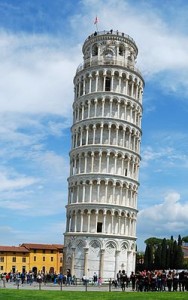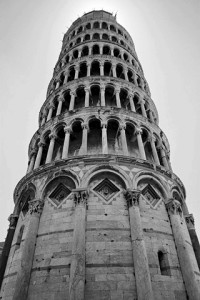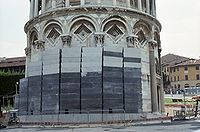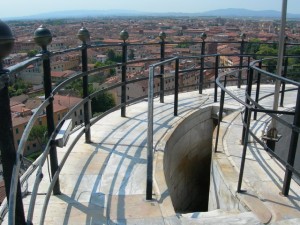#34. Tower of Pisa
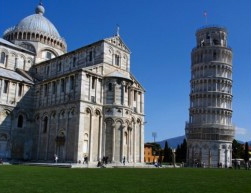
The Leaning Tower of Pisa
It’s a marble masterpiece, one of the most famous buildings in the world. The Leaning Tower of Pisa is simply an impossibility. More like something you dream than something that can exist. For hundreds of years, the world has watched in amazement as the building defies gravity, teetering on a razor’s edge. It really is quite miraculous that it has not fallen over. And thank goodness it hasn’t. If the Tower were to fall no one would feel it more than the people of Pisa. For them the Tower is the heart of their city. It is what draws hundreds of thousands of tourists every year, each one anxious to give a helping hand. It really needs one. The Leaning Tower of Pisa can tumble in an instant. For 800 years architects and engineers have been trying to fix the Leaning Tower of Pisa. Nearly every attempt has been disastrous. But somehow the Tower has serenely survived. Today the Tower is in greater danger than ever. It’s lean is so extreme that the Italian government has closed it to avoid a potential disaster. It’s been more than ten years since anyone has walked up its marble stairway which leads to its stunning bell chamber… until now. We will take a behind the scenes look inside the Tower that’s been locked off to the public for so long and climb to the top for a rare view of its breathtaking vistas. We’ll examine the bizarre history of the 800 year effort to save the Tower and introduce the current plan that some believe just may make the Tower safe forever, that is if it doesn’t destroy it first.
 Tower of Pisa Location: Pisa, Italy Architect: Several Hands at Work Year: 1372
Tower of Pisa Location: Pisa, Italy Architect: Several Hands at Work Year: 1372
No matter how you shake it, getting a building to lean back more than 600 years before the birth of Fat Joe is an awesome achievement.
The Leaning Tower of Pisa (Italian: Torre pendente di Pisa) or simply theTower of Pisa (Torre di Pisa) is the campanile, or freestanding bell tower, of the cathedral of the Italian city of Pisa, known worldwide for its unintended tilt to one side. It is situated behind the Cathedral and is the third oldest structure in Pisa’s Cathedral Square (Piazza del Duomo) after the Cathedral and the Baptistry. The tower’s tilt began during construction, caused by an inadequate foundation on ground too soft on one side to properly support the structure’s weight. The tilt increased in the decades before the structure was completed, and gradually increased until the structure was stabilized (and the tilt partially corrected) by efforts in the late 20th and early 21st centuries.
Leaning Tower of Pisa
The height of the tower is 55.86 metres (183.27 feet) from the ground on the low side and 56.67 metres (185.93 feet) on the high side. The width of the walls at the base is 2.44 m (8 ft 0.06 in). Its weight is estimated at 14,500 metric tons (16,000 short tons). The tower has 296 or 294 steps; the seventh floor has two fewer steps on the north-facing staircase. Prior to restoration work performed between 1990 and 2001, the tower leaned at an angle of 5.5 degrees, but the tower now leans at about 3.99 degrees. This means that the top of the tower is displaced horizontally 3.9 metres (12 ft 10 in) from where it would be if the structure were perfectly vertical.
Architect
There has been controversy about the real identity of the architect of the Leaning Tower of Pisa. For many years, the design was attributed to Guglielmo and Bonanno Pisano, a well-known 12th-century resident artist of Pisa, famous for his bronze casting, particularly in the Pisa Duomo. Bonanno Pisano left Pisa in 1185 for Monreale, Sicily, only to come back and die in his home town. A piece of cast with his name was discovered at the foot of the tower in 1820, but this may be related to the bronze door in the façade of the cathedral that was destroyed in 1595. However, recent studies seem to indicate Diotisalvi as the original architect due to the time of construction and affinity with other Diotisalvi works, notably the bell tower of San Nicola and the Baptistery, both in Pisa. However, he usually signed his works and there is no signature by him in the bell tower which leads to further speculation.
Construction
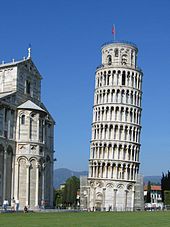 Leaning Tower of Pisa before cleaning work had taken place
Leaning Tower of Pisa before cleaning work had taken place
Construction of the tower occurred in three stages across 199 years. Work on the ground floor of the white marble campanile began on August 14, 1173, during a period of military success and prosperity. This ground floor is a blind arcade articulated by engaged columns with classical Corinthian capitals.
The tower began to sink after construction had progressed to the second floor in 1178. This was due to a mere three-metre foundation, set in weak, unstable subsoil, a design that was flawed from the beginning. Construction was subsequently halted for almost a century, because the Republic of Pisa was almost continually engaged in battles with Genoa, Lucca, and Florence. This allowed time for the underlying soil to settle. Otherwise, the tower would almost certainly have toppled. In 1198 clocks were temporarily installed on the third floor of the unfinished construction.
In 1272 construction resumed under Giovanni di Simone, architect of the Camposanto. In an effort to compensate for the tilt, the engineers built upper floors with one side taller than the other. Because of this, the tower is actually curved. Construction was halted again in 1284, when the Pisans were defeated by the Genoans in the Battle of Meloria.
The seventh floor was completed in 1319. It was built by Tommaso di Andrea Pisano, who succeeded in harmonizing the Gothic elements of the bell-chamber with the Romanesque style of the tower. There are seven bells, one for each note of the musical major scale. The largest one was installed in 1655. The bell-chamber was finally added in 1372.
After a phase (1990–2001) of structural strengthening, the tower is currently undergoing gradual surface restoration, in order to repair visible damage, mostly corrosion and blackening. These are particularly pronounced due to the tower’s age and its exposure to wind and rain.
Timeline
- On January 5, 1172, Donna Berta di Bernardo, a widow and resident of the house of dell’Opera di Santa Maria, bequeathed sixty soldi to the Opera Campanilis petrarum Sancte Marie. The sum was then used toward the purchase of a few stones which still form the base of the bell tower.
- On August 9, 1173, the foundations of the Tower were laid.
- Nearly four centuries later Giorgio Vasari wrote: “Guglielmo, according to what is being said, in [this] year 1174 with Bonanno as sculptor, laid the foundations of the bell tower of the cathedral in Pisa.”
- Giorgio Vasari indicates that Tommaso di Andrea Pisano was the designer of the belfry between 1360 and 1370.
- On December 27, 1233, the worker Benenato, son of Gerardo Bottici, oversaw the continuation of the construction of the bell tower.
- On February 23, 1260, Guido Speziale, son of Giovanni, a worker on the cathedral Santa Maria Maggiore, was elected to oversee the building of the Tower.
- On April 12, 1264, the master builder Giovanni di Simone and 23 workers went to the mountains close to Pisa to cut marble. The cut stones were given to Rainaldo Speziale, worker of St. Francesco.
Builders
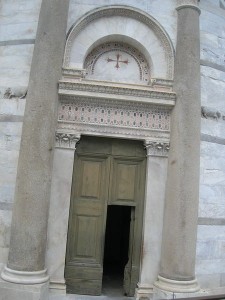 Entrance door to the bell tower
Entrance door to the bell tower
- One possible builder is Gerardo di Gerardo. His name appears as a witness to the above legacy of Berta di Bernardo as “Master Gerardo”, and as a worker whose name was Gerardo.
- A more probable builder is Diotisalvi, because of the construction period and the structure’s affinities with other buildings in Pisa. But he usually signed his works, and there is no signature by him in the bell tower.
- Giovanni di Simone was heavily involved in the completion of the tower, under the direction of Giovanni Pisano, who at the time was master builder of the Opera di Santa Maria Maggiore. He could be the same Giovanni Pisano who completed the belfry tower.
History following construction
Galileo Galilei is said to have dropped two cannonballs of different masses from the tower to demonstrate that their speed of descent was independent of their mass. However, this is considered an apocryphal tale, its only source being Galileo’s secretary.
During World War II, the Allies discovered that the Germans were using the tower as an observation post. A U.S. Army sergeant sent to confirm the presence of German troops in the tower was impressed by the beauty of the cathedral and its campanile, and thus refrained from ordering an artillery strike, sparing it from destruction.
On February 27, 1964, the government of Italy requested aid in preventing the tower from toppling. It was, however, considered important to retain the current tilt, due to the role that this element played in promoting the tourism industry of Pisa.
A multinational task force of engineers, mathematicians, and historians gathered on the Azores islands to discuss stabilisation methods. It was found that the tilt was increasing in combination with the softer foundations on the lower side. Many methods were proposed to stabilise the tower, including the addition of 800 tonnes of lead counterweights to the raised end of the base.
In 1987 the tower was declared as part of the Piazza del Duomo UNESCO World Heritage Site along with the neighbouring cathedral, baptistery and cemetery.
On January 7, 1990, after over two decades of stabilisation studies, and spurred by the abrupt collapse of the Civic Tower of Pavia in 1989, the tower was closed to the public. The bells were removed to relieve some weight, and cables were cinched around the third level and anchored several hundred meters away. Apartments and houses in the path of the tower were vacated for safety. The final solution to prevent the collapse of the tower was to slightly straighten the tower to a safer angle, by removing 38 cubic metres (1,342 cubic feet) of soil from underneath the raised end. The tower was straightened by 45 centimetres (17.7 inches), returning to its 1838 position. After a decade of corrective reconstruction and stabilization efforts, the tower was reopened to the public on December 15, 2001, and was declared stable for at least another 300 years.
In May 2008, after the removal of another 70 metric tons (77 short tons) of ground, engineers announced that the Tower had been stabilized such that it had stopped moving for the first time in its history. They stated it would be stable for at least 200 years.
Alternative Candidates
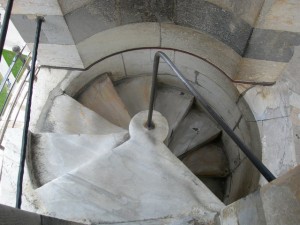 Inner staircase from seventh to eighth (the top) floor
Inner staircase from seventh to eighth (the top) floor
Two German churches have challenged the tower’s status as the world’s most lop-sided building: the 15th-century square Leaning Tower of Suurhusen and the 14th-century bell tower in the town of Bad Frankenhausen. Guinness World Records measured the Pisa and Suurhusen towers, finding the former’s tilt to be 3.97 degrees. In June 2010 Guinness World Records certified the Capital Gate building in Abu Dhabi, UAE as the “World’s Furthest Leaning Man-made Tower.” The Capital Gate tower has an 18-degree slope, almost five times more than the Pisa Tower; however the Capital Gate tower has been deliberately engineered to slant. The Leaning Tower of Wanaka in New Zealand, also deliberately built, leans at 53 degrees to the ground.
Technical Information
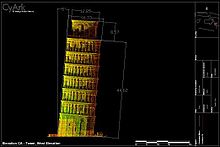 An elevation image of the Leaning Tower of Pisa cut with laser scan data from a University of Ferrara/CyArk research partnership, with source image accurate down to 5 mm (0.2 in). This elevation shows the interesting quandary facing the campanile. The circular shape and great height (currently 55.86 m (183 ft 3.21 in) on the lowest side and 56.67 m (185 ft 11.10 in) m on the highest) of the campanile were unusual for their time, and the crowning belfry is stylistically distinct from the rest of the construction. This belfry incorporates a 14 cm (5.5 in) correction for the inclined axis below. The siting of the campanile within the Piazza del Duomo diverges from the axial alignment of the cathedral and baptistery of the Piazza del Duomo
An elevation image of the Leaning Tower of Pisa cut with laser scan data from a University of Ferrara/CyArk research partnership, with source image accurate down to 5 mm (0.2 in). This elevation shows the interesting quandary facing the campanile. The circular shape and great height (currently 55.86 m (183 ft 3.21 in) on the lowest side and 56.67 m (185 ft 11.10 in) m on the highest) of the campanile were unusual for their time, and the crowning belfry is stylistically distinct from the rest of the construction. This belfry incorporates a 14 cm (5.5 in) correction for the inclined axis below. The siting of the campanile within the Piazza del Duomo diverges from the axial alignment of the cathedral and baptistery of the Piazza del Duomo
- Elevation of Piazza del Duomo: about 2 metres (6 feet, DMS)
- Height from the ground floor: 55.863 metres (183 ft 3 in), 8 stories
- Height from the foundation floor: 58.36 m (191 ft 5.64 in)
- Outer diameter of base: 15.484 metres (50 ft 9.6 in)
- Inner diameter of base: 7.368 metres (24 ft 2.1 in)
- Angle of slant: 3.97 degrees or 3.9 metres (12 ft 10 in) from the vertical
- Weight: 14,700 metric tons (16,200 short tons)
- Thickness of walls at the base: 2.44 metres (8 ft 0 in)
- Total number of bells: 7, tuned to musical scale, clockwise
-
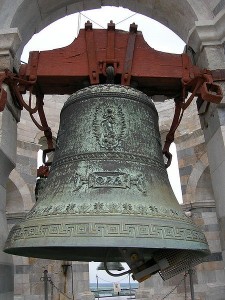 Pasquareccia bell
Pasquareccia bell- 1st bell: L’Assunta, cast in 1654 by Giovanni Pietro Orlandi, weight 3,620 kg (7,981 lb)
- 2nd bell: Il Crocifisso, cast in 1572 by Vincenzo Possenti, weight 2,462 kg (5,428 lb)
- 3rd bell: San Ranieri, cast in 1719–1721 by Giovanni Andrea Moreni, weight 1,448 kg (3,192 lb)
- 4th bell: La Terza (1st small one), cast in 1473, weight 300 kg (661 lb)
- 5th bell: La Pasquereccia or La Giustizia, cast in 1262 by Lotteringo, weight 1,014 kg (2,235 lb)
- 6th bell: Il Vespruccio (2nd small one), cast in the 14th century and again in 1501 by Nicola di Jacopo, weight 1,000 kg (2,205 lb)
- 7th bell: Dal Pozzo, cast in 1606 and again in 2004, weight 652 kg (1,437 lb)
- Number of steps to the top: 296
About the 5th bell: The name Pasquareccia comes from Easter, because it used to ring on Easter day. However, this bell is older than the bell-chamber itself, and comes from the tower Vergata in Palazzo Pretorio in Pisa, where it was called La Giustizia (The Justice). The bell was tolled to announce executions of criminals and traitors, including Count Ugolino in 1289. A new bell was installed in the bell tower at the end of the 18th century to replace the broken Pasquareccia.

